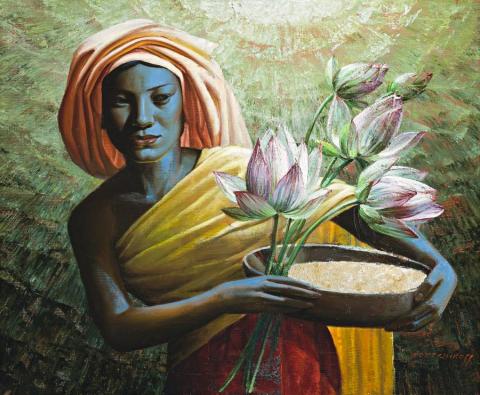THE RICE LADY
VLADIMIR TRETCHIKOFF
oil and rice on canvas
70.5 x 85.5 cm
signed lower right: TRETCHIKOFF
Purchased directly from the artist, South Africa, 1979
Private collection, Cape Town, South Africa
Thence by descent
Private collection, Canberra
This work has been requested for loan and inclusion in the Tretchikoff retrospective exhibition, May – September 2011, Iziko South African National Gallery, Cape Town, South Africa.
Although born in Russia in 1913, Vladimir Tretchikoff left shortly thereafter when his family fled the revolution as refugees to Harbin, Northern China. As a schoolboy, he painted theatre sets at a local Chinese opera house, and in 1932 he moved to Shanghai, where he earned a living as a cartoonist for English newspapers. When World War II erupted, Tretchikoff was working in Malaya illustrating allied propaganda publications until the Japanese invaded and both he and his wife were evacuated in separate boats. Unfortunately however, his boat was sunk and he consequently endured several years as a prisoner of war on the island of Bali. When the war finally ended, after years of no communication, he discovered his wife living in South Africa and joined her there, where he spent the remainder of his life in Cape Town.
One of the most commercially successful artists of the twentieth century, Vladimir Tretchikoff is widely acclaimed for his images of exotic yet demure women which appealed particularly to a public recovering from the upheavals of war. Although his paintings sold to wealthy clients for extraordinary sums, it was his mass-produced prints that adorned the walls of suburban houses around the globe during the 1950s and 60s. Indeed, so great was the demand for his images that his iconic work The Chinese Girl 1952 has been more widely reproduced than the Mona Lisa and moreover, is now regarded the best-selling commercial print of all time. Remarkably, at the height of his fame, in 1961 his exhibition at Harrods, London attracted over 200,000 visitors - a figure that eclipsed all other art exhibitions in that year, including a touring Picasso exhibition.
Dating from his 'golden period' which stretched from the late 1940s until the mid 1960s, the present Rice Lady exemplifies well the bold palette so typical of these works - the model is depicted as if viewed through a blue filter, her skin contrasting with the orange, yellow and red of her traditional costume while the background has a wave-like energy generated from contrasting colours applied thickly with a palette knife. Always seeking to surprise and delight his audience, Tretchikoff often experimented with adjunct materials and accordingly, here he has applied actual rice grains to the surface of the painting. Like all classic Tretchikoff works, the energy of the work is balanced with the serenity of the model. The lotus flowers and the offering of food here are perhaps a Balinese Hindu offering to the gods and impart a sense of religious calm; certainly, echoes of his Bali experience during the war pervade many of his classic works from the 1950s such as Fruits of Bali.
While Tretchikoff was often scorned by critics for his overtly commercial practice, in more recent years he has been championed by postmodern artists, designers and cultural historians in their reassessment of his influence upon twentieth-century art practice - and notably, in his adopted home of South Africa, the first major retrospective exhibition of his work is being held later this year at Iziko South African National Gallery.
RICHARD ENNIS
